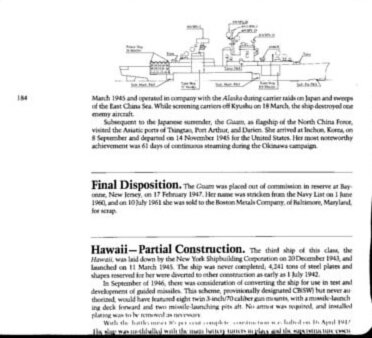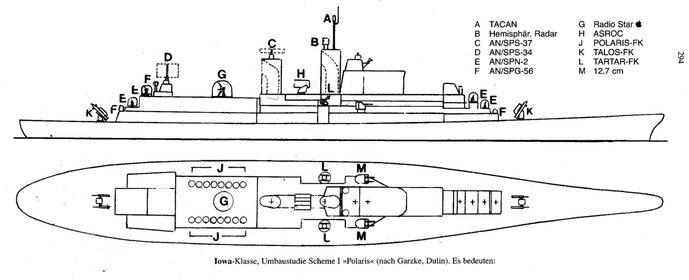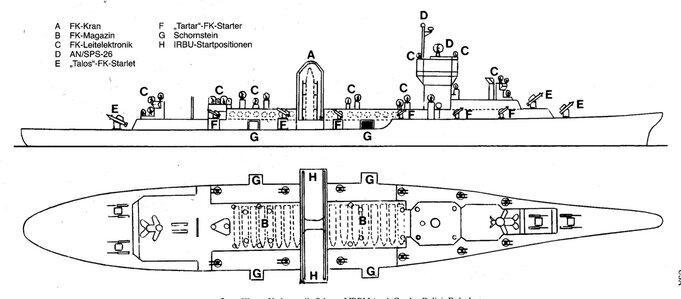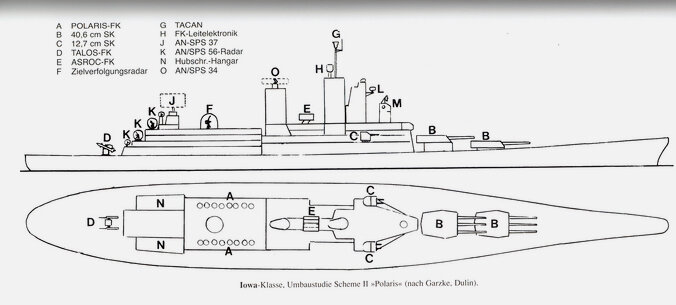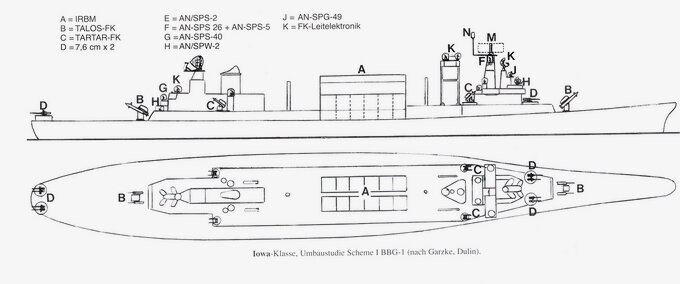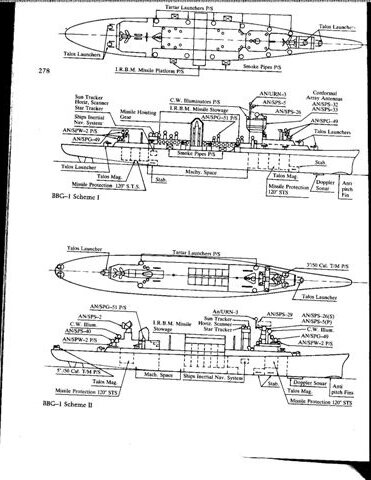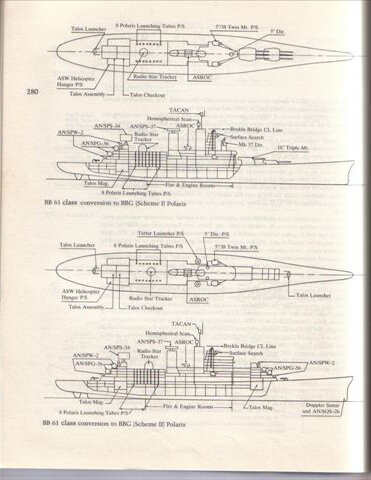You are using an out of date browser. It may not display this or other websites correctly.
You should upgrade or use an alternative browser.
You should upgrade or use an alternative browser.
Iowa and Alaska Class Conversion Projects
- Thread starter Triton
- Start date
Firefinder
ACCESS: Top Secret
- Joined
- 5 October 2019
- Messages
- 1,048
- Reaction score
- 1,900
Also you can multipack like 7 MK41 missiles cells into even a Polaris size tube like they did with the Ohios SSGNs and Virginias Payload Module.Considering all the hoopla over hypersonics and "payloads over platforms" I'd say revisiting large diameters tubes on surface ships would be a good idea. Heck I think that should be the next forum WhatIf?Polaris IRBM on a surface ship ? that was the very core of NATO MLF (because nuke submarines were too expensive for European navies) - and was thoroughly shot down as "idiotic".
Also I will like to point out this thread here on Shipbucket.
Someone found the ACTUAL draws for the 4 Talo's Iowa's.
That he got from these two books.
Battleships: United States Battleships, 1935-1992 Hardcover – April 1, 1995
by William H. Garzke Jr. (Author), Robert O. Dulin Jr. (Author)ANd this one, (Note I have this one and I Fully recommand it. Even got designs for converting the Iowa's into Fast Replenishment Ships)
US Battleship Conversion Projects 1942-1965 an illustrated technical reference Paperback – February 5, 2013




Firefinder
ACCESS: Top Secret
- Joined
- 5 October 2019
- Messages
- 1,048
- Reaction score
- 1,900
These apperantly are the Sketch drawings from the US Navy Archive for the second book.I would still check the original sketch drawings from one of the US archives.
That large missile looks not like a UGM/RGM-27 Polaris at all!
That is because it predates the Polaris and is actually uses the Jupiter, the liquid fuel ICBM that was Joint Army-Navy before the Navy decided to split off to looking into solid fuels. Which became the Polaris about five years later or so.
The missiles might be Jupiter - the Navy option before solid fuel progressed enough for Polaris ...
NINJA'D by @Firefinder lol
NINJA'D by @Firefinder lol
- Joined
- 27 September 2006
- Messages
- 6,417
- Reaction score
- 6,817
Fun though cruisers are, surely the optimum surface to surface missile platform is the nuclear submarine.
The modern cruiser should be a long range SAM/ABM platform to shield a task group or even a coastal area.
Long range ASW like Sea Lance is also better on submarines.
As a bonus VLS allows SSM and ASW to be carried. A large tube VLS or Kirov style slant LS would be essential. Carrying something like Thaad or Arrow?
The modern cruiser should be a long range SAM/ABM platform to shield a task group or even a coastal area.
Long range ASW like Sea Lance is also better on submarines.
As a bonus VLS allows SSM and ASW to be carried. A large tube VLS or Kirov style slant LS would be essential. Carrying something like Thaad or Arrow?
Firefinder
ACCESS: Top Secret
- Joined
- 5 October 2019
- Messages
- 1,048
- Reaction score
- 1,900
If the Army 1000 mile range Strategic Long Range Cannon works, I can see the return of the Monitor-lets be real it be called battleship-classiftation.Fun though cruisers are, surely the optimum surface to surface missile platform is the nuclear submarine.
The modern cruiser should be a long range SAM/ABM platform to shield a task group or even a coastal area.
Long range ASW like Sea Lance is also better on submarines.
As a bonus VLS allows SSM and ASW to be carried. A large tube VLS or Kirov style slant LS would be essential. Carrying something like Thaad or Arrow?
A ship with SLRCs and KIE level ABM systems plus the usual SAMs will be a very useful tool to lock down areas, and support the troops cheaply and safely. Since most shipbase ABM Radars max out at about 1000 miles of range, the areas where we will put an ABM ship will be similar to a SLRC ship. Combining the two on one hull will allow you to do STRATEGIC COUNTERFIRES if you wanted too.
Which will be real painful for the SCUD type weapons users, even more so since the Army wants to have the SLRC shells, really hypersonic vehicles using a gun as the booster, to be able to seek out moving targets.
So set up the modern Monitor in a good spot, and it can monitor the area.
...
I'll see myself out...
- Joined
- 5 May 2007
- Messages
- 1,483
- Reaction score
- 2,859
Remember that Polaris wasn't initially seen as a purely strategic weapons system. It was also seen as having a tactical role to reach out and touch targets beyond the range of a carrier task force's aircraft, in the days when nuclear weapons were seen as the solution to all military problems.Polaris IRBM on a surface ship ? that was the very core of NATO MLF (because nuke submarines were too expensive for European navies) - and was thoroughly shot down as "idiotic".
You are right. I have some difficulty grasping this (below) was even considered.
You hit the nail on the head there. Ah, the 50's and 60's... those were the (scary) days.
What killed that trend, really ? the Cuban missile crisis scary crisis ?
"Prompt global strike" - with another name and in a very different context.
When it was believed that *ballistic missiles* - with or without nukes - could be used as surrogate strike aircraft / bombers.
Things like a non-nuclear Polaris with some kind of cluster-bomb-warhead to wreck an airfield (such as Port Stanley during the Falklands) using a submarine. Who needs Black Buck Vulcans or a JP233 Tornado, really ?
in the days when nuclear weapons were seen as the solution to all military problems.
You hit the nail on the head there. Ah, the 50's and 60's... those were the (scary) days.
What killed that trend, really ? the Cuban missile crisis scary crisis ?
"Prompt global strike" - with another name and in a very different context.
When it was believed that *ballistic missiles* - with or without nukes - could be used as surrogate strike aircraft / bombers.
Things like a non-nuclear Polaris with some kind of cluster-bomb-warhead to wreck an airfield (such as Port Stanley during the Falklands) using a submarine. Who needs Black Buck Vulcans or a JP233 Tornado, really ?
- Joined
- 9 October 2009
- Messages
- 21,973
- Reaction score
- 13,624
Though it could only take out relatively non-mobile and non-hardened targets due to guidance system limitations. That is why it ended up being a primarily countervalue system, though it would have still have had a sub-strategic role due to the ill-advised cancellation of Regulus II.Remember that Polaris wasn't initially seen as a purely strategic weapons system. It was also seen as having a tactical role to reach out and touch targets beyond the range of a carrier task force's aircraft, in the days when nuclear weapons were seen as the solution to all military problems.
- Joined
- 1 February 2011
- Messages
- 2,939
- Reaction score
- 3,624
I wonder... The Regulus II looked like a jet aircraft and likely behaved as such. Could it had been further developed into a sort of UAV? or with defense mechanisms found on military aircraft? (Chaff, Flare, ECM/ECCM)
Does the Soviet Anti ship missiles had such defensive measures???
Does the Soviet Anti ship missiles had such defensive measures???
- Joined
- 9 October 2009
- Messages
- 21,973
- Reaction score
- 13,624
It was possible. And with regards as to Soviet ASMs, the later ones did indeed have ECM/ECCM built in as standard.
- Joined
- 5 May 2007
- Messages
- 1,483
- Reaction score
- 2,859
I think it's helpful to think in terms of Tomahawk - TLAM-N is pretty comparable to Polaris A1. I think it's generally accepted that TLAM-N was targeted a sub-strategic way against things like airfields and naval bases. Sub-strategic Polaris would probably be used in a similar way.Though it could only take out relatively non-mobile and non-hardened targets due to guidance system limitations.
The former is of course smaller and more accurate, but their range and warhead yield are at least pretty close. In the 1950s, when sub-strategic Polaris was on the table, it the targets would also have been softer, offsetting Polaris's inadequacy against hard targets.
- Joined
- 9 October 2009
- Messages
- 21,973
- Reaction score
- 13,624
I think some of the early ones had chaff and/or flare dispensers tied in to Radar Warning Receivers.what about the Chaff and Flare dispensers against interception missiles? (I mean on the Soviets ASMs)
T. A. Gardner
ACCESS: Top Secret
- Joined
- 18 February 2021
- Messages
- 1,152
- Reaction score
- 2,022
This wouldn't be as easy as it appears. First, any ECM / ECCM system would require ESM to detect and analyze enemy signals. Without the system knowing what the signal is and what it is for using countermeasures could well be counter productive. Generally, ESM requires some degree of human intervention to analyze signals.I wonder... The Regulus II looked like a jet aircraft and likely behaved as such. Could it had been further developed into a sort of UAV? or with defense mechanisms found on military aircraft? (Chaff, Flare, ECM/ECCM)
Does the Soviet Anti ship missiles had such defensive measures???
For example, if the missile had some very simple ESM and reacted to enemy signals it is entirely possible that it picks up a surveillance radar signal and reacts automatically by releasing chaff making it's signature much larger and easier to detect. This doesn't distract a surveillance radar the way it would a fire control one trying to pick the real target out of the clutter. Instead, the clutter itself is giving warning of a target which is the purpose of surveillance radar.
Another potential negative is the missile equipped with a library of ESM signal information is captured intact. This would give an enemy useful intelligence on what their opponent knows about their radar systems, etc.
Dilandu
I'm dissatisfied, which means, I exist.
what about the Chaff and Flare dispensers against interception missiles? (I mean on the Soviets ASMs)
The first anti-ship missile with fitted anti-interception countermeasures was P-500 "Bazalt" in 1975. Before that, no countermeasures were fitted on missiles themselves, but maritime missile-carrying bombers supported the missile launch with intense jamming "from behind".
Dilandu
I'm dissatisfied, which means, I exist.
This wouldn't be as easy as it appears. First, any ECM / ECCM system would require ESM to detect and analyze enemy signals. Without the system knowing what the signal is and what it is for using countermeasures could well be counter productive. Generally, ESM requires some degree of human intervention to analyze signals.
For example, if the missile had some very simple ESM and reacted to enemy signals it is entirely possible that it picks up a surveillance radar signal and reacts automatically by releasing chaff making it's signature much larger and easier to detect. This doesn't distract a surveillance radar the way it would a fire control one trying to pick the real target out of the clutter. Instead, the clutter itself is giving warning of a target which is the purpose of surveillance radar.
Another potential negative is the missile equipped with a library of ESM signal information is captured intact. This would give an enemy useful intelligence on what their opponent knows about their radar systems, etc.
Well, the problem could be partially solved by allowing the missile to use chaff, jammers and flares only on terminal approach - when its most likely to be intercepted. For example, about 100 miles from target the lock is released, and missile started to puff chaff clouds if tracked for some time by continuous radar beam. It's probably possible to equip "Regulus" with narrow-band ESM's, set on detecting signals in the approximate band of Soviet SAM targeting radars, and install detector capable of approximating the intensity of received signal (thus checking could the missile be in danger zone), and its duration (thus checking if the radar is locked on missile).
If all three checks are confirmed - A, the missile is receiving the beam in Soviet targeting radar band, B, the signal is powerful enough for missile to be detected, and C, the beam is staying on missile for some time - then it would release chaffs. And maybe zig-zag a bit, trying to break the lock.
- Joined
- 9 October 2009
- Messages
- 21,973
- Reaction score
- 13,624
Thought that at least one version of the Styx had countermeasure dispensers?The first anti-ship missile with fitted anti-interception countermeasures was P-500 "Bazalt" in 1975. Before that, no countermeasures were fitted on missiles themselves, but maritime missile-carrying bombers supported the missile launch with intense jamming "from behind".
Dilandu
I'm dissatisfied, which means, I exist.
Frankly, never heard of that. There were several version of P-15 Termit (Styx), not counting Chinese:Thought that at least one version of the Styx had countermeasure dispensers?
* P-15 - basic version, radar-guided, launched from hangars, non-folding wing.
* P-15TG - infrared-guided version with IR-seeker
* P-15U - improved radar-guided version, launched from container launchers, with automatic wing unfolding in flight.
* P-15UTG - infrared-guided version of P-15U, with IR seeker.
* P-15M - improved, long-range radar-guided version (nuclear-capable), commissioned in 1972.
* P-15R - infrared-guided version of P-15M.
(there are a bit of confusion about exact model names).
There were also "downgraded", export versions:
* P-20 - export version of P-15U.
* P-21/22 - export versions of P-15M/R.
None of those missiles was equipped with any countermeasures. They hardly would be practical - Styx was envisioned as short-range missile (basic version have 40 km max range), and on such distance it was simpler to use carrier ship jammers to cover the missile. While P-15M version doubled the range, it was 1970s, and the missile was already planned to be replaced with news supersonic missile (which eventually became P-270 Moskit)
- Joined
- 9 October 2009
- Messages
- 21,973
- Reaction score
- 13,624
Must have been another missile I was thinking of then.
Dilandu
I'm dissatisfied, which means, I exist.
it just downed on me that, with 12 to 16 Jupiters, that's mutated Iowa would have launch capability superior to the entire Cape Canaveral, even in the 60's !

Imagine also, how spectacular would be the explosion, if she would be hit by Soviet air-launched anti-ship missile while preparing her Jupiters...
- Joined
- 19 July 2016
- Messages
- 4,279
- Reaction score
- 3,462
Not sure that would polish out.
A floating Atlas Centaur AC-5, for sure ! Boom goes the dynamite !
View: https://www.youtube.com/watch?v=Tk2sBNT4U6A
HMS Hood "I died in a fiery explosion "
USS Kentucky "Pfff. Pussy ! I ate a Soviet ASM + 16*Jupiter explosion, and lived to see the day."
HMS Hood "I died in a fiery explosion "
USS Kentucky "Pfff. Pussy ! I ate a Soviet ASM + 16*Jupiter explosion, and lived to see the day."
Dilandu
I'm dissatisfied, which means, I exist.
A question: where there any plans for "single-end" "Alaska"'s? I.e. for their conversion into missile ship, with the rear turret removed & replaced with missile system, and forward turrets retained?
Julio Garay Terrazas
ACCESS: Confidential
- Joined
- 23 March 2020
- Messages
- 115
- Reaction score
- 257
I have these very old images that I download 20 years ago i believe... Excuse me if someone are repeat, but I prefer put the complete serie.
Attachments
- Joined
- 1 February 2011
- Messages
- 2,939
- Reaction score
- 3,624
Not necessary it was probably that they were best kept together.Was is it necessary for the Terrier launcher's to be within a certain distance from the fire control radars?
Though I'm not sure if a starboard side radar director could guide a missile launched from the port side.
Dilandu
I'm dissatisfied, which means, I exist.
Actually it was necessary for beam-riding models: missile must be gathered by beam as soon as possible.Not necessary it was probably that they were best kept together.
- Joined
- 1 February 2011
- Messages
- 2,939
- Reaction score
- 3,624
Yes, but what about semi-active homers like Terrier or Tartar?Actually it was necessary for beam-riding models: missile must be gathered by beam as soon as possible.Not necessary it was probably that they were best kept together.
Dilandu
I'm dissatisfied, which means, I exist.
Yes, but what about semi-active homers like Terrier or Tartar?
Early models of Terrier were beam-riders. If I recall correctly, all Terrier-capable ships were fitted for both beam-riding and semi-active models (since, for example, nuclear Terrier RIM-2D existed only as beam-riding model)
- Joined
- 9 October 2009
- Messages
- 21,973
- Reaction score
- 13,624
- Joined
- 9 October 2009
- Messages
- 21,973
- Reaction score
- 13,624
- Joined
- 9 October 2009
- Messages
- 21,973
- Reaction score
- 13,624
Just after President Kennedy May 1961 call for a lunar landing before the end of the decade, there was a lot of proposals for boosters capable to take a manned lander to the Moon: ever growing Saturns, and Novas built with the most diverse combination of stages, liquid, solid and nuclear. One of the least known proposals, and the only one, to my knowledge, that was totally composed of solid staged (four) for the lunar trajectory insertion of the payload, was proposed in August 1961 by Jet Propulsion Laboratory. NASA headquarters charged Space Technology Laboratories of Los Angeles (Ca) to evaluate the proposal. STl actually did more that that, re-elaboratoed and refined the all-solid Nova concept, using an Apollo based lunar lander as payload (JPL had used a different capsule, that seems the Convair Astro M-1 proposal...).
So, behold these solid behemoths. First and second stages for both configuration were composed by 300-in monolithic solids, third and fourth of the JPL-s one were monolithic 222-in, 165-in for STL.
One of the method proposed by STL to launch this Nova was an offshore based protected by a semicircular breakwater, serviced by a modified Iowa-class battleship with a 1,500-ton crane in lieu of the aft turret.
Well it would certainly take an Iowa to resist the blast of such a behemoth detonating at low altitude.
In passing, Hazegrayart (the gifted CGI genius) has done a rather astonishing video of all four N-1 failures. The July 3, 1969 BIG KABOOOOOOM is pretty amazing
(at 2: 57 in the video: and CRAAAACK goes the camera lense ! )
View: https://www.youtube.com/watch?v=4hZ5Ep06TTk
In passing, Hazegrayart (the gifted CGI genius) has done a rather astonishing video of all four N-1 failures. The July 3, 1969 BIG KABOOOOOOM is pretty amazing
(at 2: 57 in the video: and CRAAAACK goes the camera lense ! )
- Joined
- 16 December 2010
- Messages
- 3,810
- Reaction score
- 4,199
I found this 1946 article from the Toledo Blade linked to the Wikipedia article. It specifcally mentions Project Bumblebee (e.g. Talos) as one weapon proposed at that time, the other specific one is the V-2.
Toledo Blade: Rockets May Be Main Batteries for 2 Battleships
For what it's worth the other 'battleship' is the USS Hawaii.
Toledo Blade: Rockets May Be Main Batteries for 2 Battleships
For what it's worth the other 'battleship' is the USS Hawaii.
Firefinder
ACCESS: Top Secret
- Joined
- 5 October 2019
- Messages
- 1,048
- Reaction score
- 1,900
Welp this just posted in a Discord Im in.
USS ALASKA CB-1 V2 guided missile ship study plan 1947 BUSHIPS US Navy CB-2 3
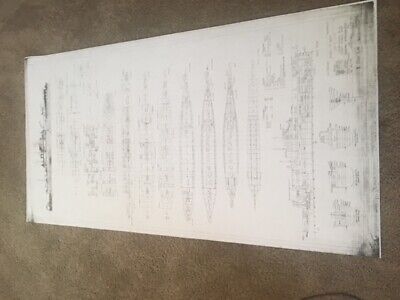
USS ALASKA CB-1 V2 guided missile ship study plan 1947 BUSHIPS US Navy CB-2 3

USS ALASKA CB-1 V2 guided missile ship study plan 1947 BUSHIPS US Navy CB-2 3 | eBay
Find many great new & used options and get the best deals for USS ALASKA CB-1 V2 guided missile ship study plan 1947 BUSHIPS US Navy CB-2 3 at the best online prices at eBay! Free shipping for many products!
www.ebay.com
- Joined
- 22 January 2006
- Messages
- 4,213
- Reaction score
- 2,010
Full details here:USS ALASKA CB-1 V2 guided missile ship study plan 1947 BUSHIPS US Navy CB-2 3
US Battleship Conversion Projects 1942-1965 an illustrated technical reference : scarpaci, wayne: Amazon.es: Libros
US Battleship Conversion Projects 1942-1965 an illustrated technical reference : scarpaci, wayne: Amazon.es: Libros
www.amazon.es
Pages 78 and 79
description, specs table, two view drawings and art by the author
Soviet counterpart was P82 R1 missile conversion projects variant A and B
Soviet Battleships 1933-1957 an illustrated technical reference : scarpaci, wayne: Amazon.es: Libros
Soviet Battleships 1933-1957 an illustrated technical reference : scarpaci, wayne: Amazon.es: Libros
www.amazon.es
Page 83
Description and sketches
that_person
ACCESS: Secret
- Joined
- 25 May 2021
- Messages
- 339
- Reaction score
- 650
Do you have the source material or any other further info?Just after President Kennedy May 1961 call for a lunar landing before the end of the decade, there was a lot of proposals for boosters capable to take a manned lander to the Moon: ever growing Saturns, and Novas built with the most diverse combination of stages, liquid, solid and nuclear. One of the least known proposals, and the only one, to my knowledge, that was totally composed of solid staged (four) for the lunar trajectory insertion of the payload, was proposed in August 1961 by Jet Propulsion Laboratory. NASA headquarters charged Space Technology Laboratories of Los Angeles (Ca) to evaluate the proposal. STl actually did more that that, re-elaboratoed and refined the all-solid Nova concept, using an Apollo based lunar lander as payload (JPL had used a different capsule, that seems the Convair Astro M-1 proposal...).
So, behold these solid behemoths. First and second stages for both configuration were composed by 300-in monolithic solids, third and fourth of the JPL-s one were monolithic 222-in, 165-in for STL.
One of the method proposed by STL to launch this Nova was an offshore based protected by a semicircular breakwater, serviced by a modified Iowa-class battleship with a 1,500-ton crane in lieu of the aft turret.
Edit: Fixing autowrong
Julio Garay Terrazas
ACCESS: Confidential
- Joined
- 23 March 2020
- Messages
- 115
- Reaction score
- 257
¡¡¡¡¡¡¡¡¡¡¡¡¡¡¡¡¡¡¡¡¿Full details here:USS ALASKA CB-1 V2 guided missile ship study plan 1947 BUSHIPS US Navy CB-2 3
US Battleship Conversion Projects 1942-1965 an illustrated technical reference : scarpaci, wayne: Amazon.es: Libros
US Battleship Conversion Projects 1942-1965 an illustrated technical reference : scarpaci, wayne: Amazon.es: Libroswww.amazon.es
Pages 78 and 79
description, specs table, two view drawings and art by the author
Soviet counterpart was P82 R1 missile conversion projects variant A and B
Soviet Battleships 1933-1957 an illustrated technical reference : scarpaci, wayne: Amazon.es: Libros
Soviet Battleships 1933-1957 an illustrated technical reference : scarpaci, wayne: Amazon.es: Libroswww.amazon.es
Page 83
Description and sketches
Put images please!!!!!!!!!!!!!!!!!!!!!!!!!
Similar threads
-
-
-
Postwar Royal Navy Battleships? (NOT including the Vanguard!)
- Started by Blacktail
- Replies: 81
-
-

